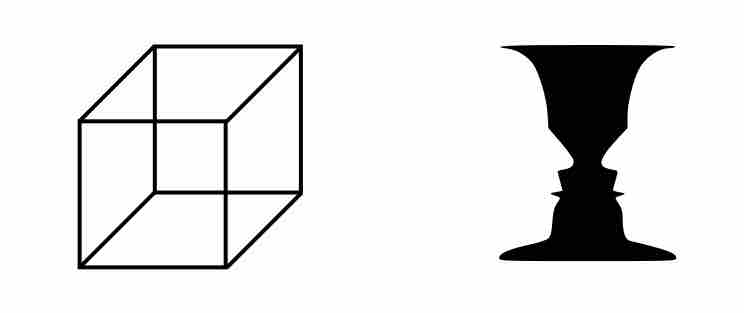Perceptual Process
The perceptual process is the sequence of psychological steps that a person uses to organize and interpret information from the outside world. The steps are:
- Objects are present in the world.
- A person observes.
- The person uses perception to select objects.
- The person organizes the perception of objects.
- The person interprets the perceptions.
- The person responds.
The selection, organization, and interpretation of perceptions can differ among different people . Therefore, when people react differently in a situation, part of their behavior can be explained by examining their perceptual process, and how their perceptions are leading to their responses.

Multistability
The Necker cube and Rubin vase can be perceived in more than one way. The vase can be seen as either a vase or two faces.
Perceptual Selection
Perceptual selection is driven by internal and external factors.
Internal factors include:
- Personality - Personality traits influence how a person selects perceptions. For instance, conscientious people tend to select details and external stimuli to a greater degree.
- Motivation - People will select perceptions according to what they need in the moment. They will favor selections that they think will help them with their current needs, and be more likely to ignore what is irrelevant to their needs.
- Experience - The patterns of occurrences or associations one has learned in the past affect current perceptions. The person will select perceptions in a way that fits with what they found in the past.
External factors include:
- Size - A larger size makes it more likely an object will be selected.
- Intensity - Greater intensity, in brightness, for example, also increases perceptual selection.
- Contrast - When a perception stands clearly out against a background, there is a greater likelihood of selection.
- Motion - A moving perception is more likely to be selected.
- Repetition - Repetition increases perceptual selection.
- Novelty and familiarity - Both of these increase selection. When a perception is new, it stands out in a person's experience. When it is familiar, it is likely to be selected because of this familiarity.
Perceptual Organization
After certain perceptions are selected, they can be organized differently. The following factors are those that determine perceptual organization:
- Figure-ground - Once perceived, objects stand out against their background. This can mean, for instance, that perceptions of something as new can stand out against the background of everything of the same type that is old.
- Perceptual grouping - Grouping is when perceptions are brought together into a pattern.
- Closure - This is the tendency to try to create wholes out of perceived parts. Sometimes this can result in error, though, when the perceiver fills in unperceived information to complete the whole.
- Proximity - Perceptions that are physically close to each other are easier to organize into a pattern or whole.
- Similarity - Similarity between perceptions promotes a tendency to group them together.
- Perceptual Constancy - This means that if an object is perceived always to be or act a certain way, the person will tend to infer that it actually is always that way.
- Perceptual Context - People will tend to organize perceptions in relation to other pertinent perceptions, and create a context out of those connections.
Each of these factors influence how the person perceives their environment, so responses to their environment can be understood by taking the perceptual process into account.